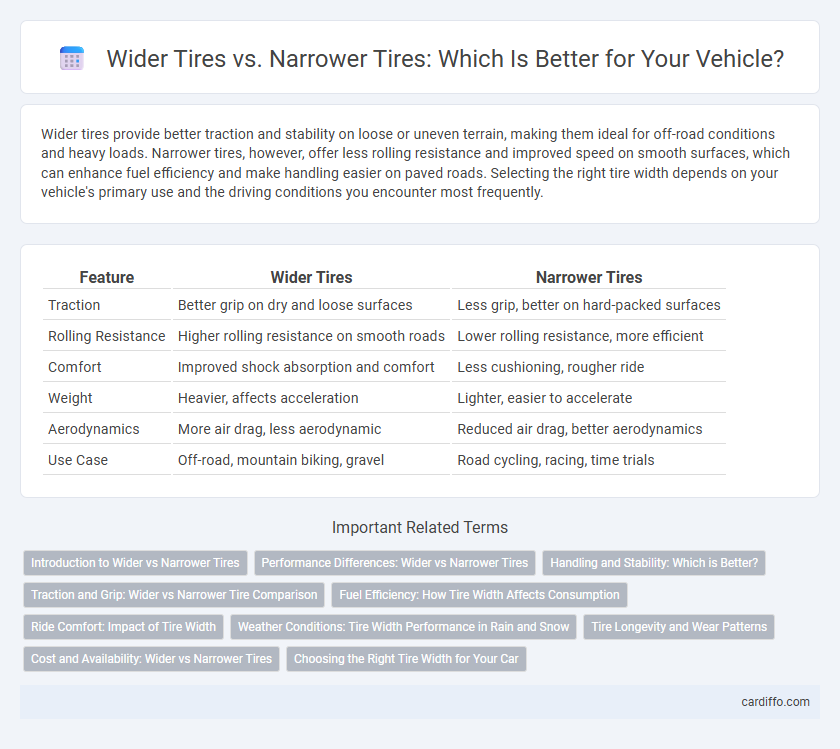Wider tires provide better traction and stability on loose or uneven terrain, making them ideal for off-road conditions and heavy loads. Narrower tires, however, offer less rolling resistance and improved speed on smooth surfaces, which can enhance fuel efficiency and make handling easier on paved roads. Selecting the right tire width depends on your vehicle's primary use and the driving conditions you encounter most frequently.
Table of Comparison
| Feature | Wider Tires | Narrower Tires |
|---|---|---|
| Traction | Better grip on dry and loose surfaces | Less grip, better on hard-packed surfaces |
| Rolling Resistance | Higher rolling resistance on smooth roads | Lower rolling resistance, more efficient |
| Comfort | Improved shock absorption and comfort | Less cushioning, rougher ride |
| Weight | Heavier, affects acceleration | Lighter, easier to accelerate |
| Aerodynamics | More air drag, less aerodynamic | Reduced air drag, better aerodynamics |
| Use Case | Off-road, mountain biking, gravel | Road cycling, racing, time trials |
Introduction to Wider vs Narrower Tires
Wider tires offer increased contact area with the road, enhancing traction and stability, especially in dry conditions. Narrower tires reduce rolling resistance and perform better in wet or snowy environments by cutting through surface water or snow more effectively. Choosing between wider and narrower tires depends on driving conditions and vehicle performance priorities.
Performance Differences: Wider vs Narrower Tires
Wider tires provide increased contact patch, enhancing grip and stability during cornering and acceleration, especially on dry surfaces. Narrower tires offer lower rolling resistance, improving fuel efficiency and performance in wet or snowy conditions by cutting through water and slush more effectively. Optimal tire width selection depends on vehicle type, driving conditions, and performance priorities, balancing traction with efficiency.
Handling and Stability: Which is Better?
Wider tires provide enhanced handling and stability by increasing the contact patch with the road, offering better grip during cornering and improved traction on wet surfaces. Narrower tires, while less stable at high speeds, reduce rolling resistance and are often preferred for fuel efficiency and performance in snowy or muddy conditions. The choice between wider and narrower tires depends on vehicle type, driving conditions, and desired balance between grip and efficiency.
Traction and Grip: Wider vs Narrower Tire Comparison
Wider tires provide increased traction and grip due to a larger contact patch with the road surface, enhancing stability during acceleration and cornering. Narrower tires, while offering less surface area, can deliver better grip on slippery or loose surfaces by concentrating the vehicle's weight over a smaller footprint. Tire width selection directly influences handling performance and safety, with wider tires favoring dry conditions and narrower tires improving control in wet or snowy environments.
Fuel Efficiency: How Tire Width Affects Consumption
Wider tires generally increase rolling resistance due to a larger contact patch, leading to higher fuel consumption compared to narrower tires. Narrower tires reduce aerodynamic drag and rolling resistance, enhancing fuel efficiency by requiring less energy to maintain speed. Choosing tire width optimized for vehicle design can significantly impact overall fuel economy and emissions.
Ride Comfort: Impact of Tire Width
Wider tires generally offer improved ride comfort by providing a larger contact patch that better absorbs road irregularities and reduces vibrations. Narrower tires, while often delivering better handling precision, transmit more road feedback and can result in a firmer ride due to their smaller surface area. Tire width impacts cushioning effectiveness, with wider options enhancing shock absorption and smoothing the driving experience on varied road surfaces.
Weather Conditions: Tire Width Performance in Rain and Snow
Wider tires provide better traction on dry surfaces but can increase hydroplaning risk in heavy rain due to a larger contact patch that disperses water less efficiently. Narrower tires perform better in snow and slush by exerting higher pressure on the road, improving grip and penetration through slippery layers. Optimal tire width selection should consider frequent weather conditions to balance traction and safety in rain and snow.
Tire Longevity and Wear Patterns
Wider tires generally offer improved traction and stability but tend to experience uneven wear, particularly on the edges due to increased surface area contact. Narrower tires typically provide more even wear patterns and longer tire longevity, as the reduced contact patch lowers rolling resistance and heat buildup. Proper maintenance, alignment, and rotation are essential for maximizing the lifespan of both wider and narrower tires.
Cost and Availability: Wider vs Narrower Tires
Wider tires generally cost more than narrower tires due to increased material usage and specialized manufacturing processes. Narrower tires tend to be more readily available across various vehicle types, making them a cost-effective choice for budget-conscious consumers. The broader market demand for narrower tires often results in greater discounts and availability in both physical stores and online retailers.
Choosing the Right Tire Width for Your Car
Choosing the right tire width affects vehicle handling, fuel efficiency, and ride comfort. Wider tires offer better grip and stability during cornering but may increase rolling resistance and fuel consumption. Narrower tires improve fuel economy and perform better in wet conditions but may reduce overall traction and handling precision.
Wider tires vs Narrower tires Infographic

 cardiffo.com
cardiffo.com